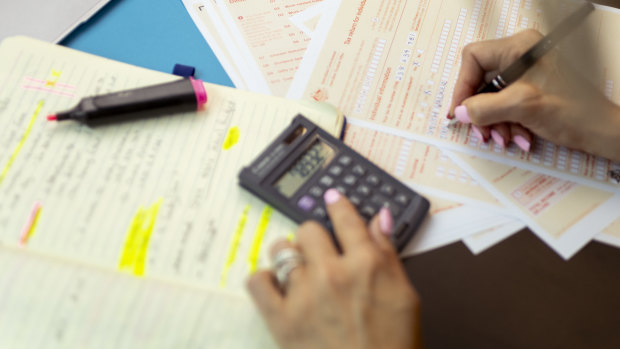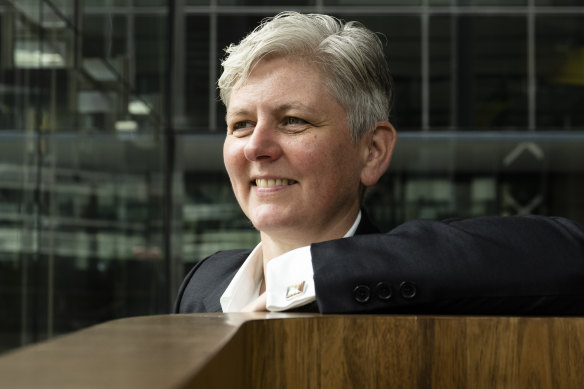This was published 5 months ago
Tax attack could be next challenge for cash-strapped shoppers
By Shane Wright
Consumers have yet to go on a spending spree with their stage 3 tax cut windfalls, with warnings a chase for up to $100 billion in unpaid tax could weigh on shoppers and the overall economy.
Amid signs more people are struggling with higher mortgage repayments, spending data collected by most of the major banks is failing to show any sizeable lift in expenditure associated with the tax cuts that were worth close to $5 billion through July and August.

Consumers are still to go on a stage 3 tax cut spending spree. One of the issues may be efforts to recoup tax.Credit: Dominic Lorrimer
Before the cuts, worth more than $23 billion through their first year of operation, economists expressed concern they might encourage consumers to lift their spending, adding to inflation and putting pressure on the Reserve Bank to further increase interest rates.
But figures from the Commonwealth and Westpac banks, tracking the spending through their credit and debit card networks, show barely any change in consumer expenditure since the cuts kicked in.
Westpac chief economist Luci Ellis said it appeared household income was not picking up quickly, noting the impact of the stage 3 tax cuts on spending was likely to “surprise on the downside rather than on the upside”.
She said one factor might be taxation.
Tax commissioner, Rob Heferen, last week said the agency would be “firmer and faster” in chasing a record $100 billion in unpaid tax.
Revealing many businesses owed tax withheld on their workers’ wages and entitlements such as superannuation, Heferen said collectable tax debt had reached $50 billion, with at least another $50 billion in overall debt owed to the ATO.
“This is critical for supporting other creditors and businesses who are doing the right thing and paying on time, and who themselves can often be left out of pocket by businesses who aren’t taking steps to manage their financial situation,” he said.
Ellis said in 2018-19, household income was weak as the tax take increased at a disproportionately fast rate due to better enforcement of rules around deductions. The same situation could play out this year.
“The result contributed to soft overall demand and inflation continually undershooting the RBA’s target despite ultra-low interest rates,” she said.
“There were other things going on in the same direction, but more effective tax collection was part of the story.”
ANZ economists have noted that while they had expected a slight lift in household spending through the second half of this year, existing consumer pessimism suggested expenditure might be softer than forecast.
They believed there was a chance of an increase in activity around the Black Friday sales in November, which have in recent years led to bargain hunting by cash-strapped shoppers, and in the run-up to Christmas.
Separate data from the Australian Prudential Regulation Authority suggests the combination of 13 interest rate increases is biting on hard-pressed borrowers.

Westpac chief economist Luci Ellis says household spending could be softer than expected.Credit: Janie Barrett
The proportion of non-performing loans held by the nation’s banks, the authority reported, had climbed to 1.03 per cent of all mortgages by the end of the June quarter. This measure had fallen to a record low of 0.68 per cent at the end of 2022.
The value of loans now at least 90 days in arrears had climbed to $23.4 billion, having increased for six consecutive quarters.
The arrears rate is highest among owner-occupiers at 1.07 per cent. The lowest rate is among investors, with interest-only loans at just 0.44 per cent.
Canstar’s data insights director, Sally Tindall, said the grind upward in mortgage repayments was starting to hurt.
“It’s concerning but by no means surprising to see the total value of mortgages in arrears continuing to climb,” she said.
“After more than two years of soaring mortgage rates, many borrowers’ budgets have been stretched to the very last dollar, while others have gone firmly into the negative.”
Oxford Economics Australia’s head of macroeconomic forecasting, Sean Langcake, said it was difficult to say whether the tax cuts would eventually overcome the cost-of-living pressures facing most Australians and drive a lift in consumption that would support the economy.
Langcake, who does not expect the Reserve Bank to start cutting interest rates until at least May next year, said the economy was sending mixed signals.
“The Australian economy is facing strong cross-currents that are making for a challenging outlook and environment for policymakers,” he said.
“The labour market has defied a marked slowdown in activity, which is testing the RBA’s very patient approach to bringing inflation back to its target. Concurrently, a significant easing in fiscal policy will give the economy a boost, which is welcome for households, but less so for inflation hawks.”
Debate on economic management has centred in recent weeks on proposed changes to the Reserve Bank.
Coalition finance spokesman Jane Hume on Sunday confirmed her party’s opposition to the proposals despite previous enthusiasm. She also flagged cuts to government spending in an ABC interview, prompting Treasurer Jim Chalmers to question whether a Coalition government would cut wages or social security.
Cut through the noise of federal politics with news, views and expert analysis. Subscribers can sign up to our weekly Inside Politics newsletter.